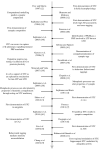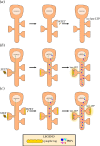Synapses tagged, memories kept: synaptic tagging and capture hypothesis in brain health and disease
- PMID: 38853570
- PMCID: PMC11343274
- DOI: 10.1098/rstb.2023.0237
Synapses tagged, memories kept: synaptic tagging and capture hypothesis in brain health and disease
Abstract
The synaptic tagging and capture (STC) hypothesis lays the framework on the synapse-specific mechanism of protein synthesis-dependent long-term plasticity upon synaptic induction. Activated synapses will display a transient tag that will capture plasticity-related products (PRPs). These two events, tag setting and PRP synthesis, can be teased apart and have been studied extensively-from their electrophysiological and pharmacological properties to the molecular events involved. Consequently, the hypothesis also permits interactions of synaptic populations that encode different memories within the same neuronal population-hence, it gives rise to the associativity of plasticity. In this review, the recent advances and progress since the experimental debut of the STC hypothesis will be shared. This includes the role of neuromodulation in PRP synthesis and tag integrity, behavioural correlates of the hypothesis and modelling in silico. STC, as a more sensitive assay for synaptic health, can also assess neuronal aberrations. We will also expound how synaptic plasticity and associativity are altered in ageing-related decline and pathological conditions such as juvenile stress, cancer, sleep deprivation and Alzheimer's disease. This article is part of a discussion meeting issue 'Long-term potentiation: 50 years on'.
Keywords: Synaptic Tagging; hippocampus; long-term depression; long-term potentiation; memory; synaptic plasticity; synaptic tagging and capture.
Conflict of interest statement
The authors declare no competing interests.
Figures


Similar articles
-
The tagging and capture hypothesis from synapse to memory.Prog Mol Biol Transl Sci. 2014;122:391-423. doi: 10.1016/B978-0-12-420170-5.00013-1. Prog Mol Biol Transl Sci. 2014. PMID: 24484708 Review.
-
Long-term plasticity in the hippocampus: maintaining within and 'tagging' between synapses.FEBS J. 2022 Apr;289(8):2176-2201. doi: 10.1111/febs.16065. Epub 2021 Jun 25. FEBS J. 2022. PMID: 34109726 Review.
-
A computational model to explore how temporal stimulation patterns affect synapse plasticity.PLoS One. 2022 Sep 23;17(9):e0275059. doi: 10.1371/journal.pone.0275059. eCollection 2022. PLoS One. 2022. PMID: 36149886 Free PMC article.
-
Beyond boundaries: extended temporal flexibility in synaptic tagging and capture.Commun Biol. 2025 Apr 4;8(1):553. doi: 10.1038/s42003-025-07998-w. Commun Biol. 2025. PMID: 40181131 Free PMC article.
-
Synapse-specific stabilization of plasticity processes: the synaptic tagging and capture hypothesis revisited 10 years later.Neurosci Biobehav Rev. 2008;32(4):831-51. doi: 10.1016/j.neubiorev.2008.01.002. Epub 2008 Jan 15. Neurosci Biobehav Rev. 2008. PMID: 18281094 Review.
Cited by
-
Long-term potentiation: 50 years on: past, present and future.Philos Trans R Soc Lond B Biol Sci. 2024 Jul 29;379(1906):20230218. doi: 10.1098/rstb.2023.0218. Epub 2024 Jun 10. Philos Trans R Soc Lond B Biol Sci. 2024. PMID: 38853569 Free PMC article.
-
The Molecular Substrates of Second-Order Conditioned Fear in the Basolateral Amygdala Complex.J Neurosci. 2025 Jun 18;45(25):e1087242025. doi: 10.1523/JNEUROSCI.1087-24.2025. J Neurosci. 2025. PMID: 40345834
References
-
- Alarcon JM, Barco A, Kandel ER. 2006. Capture of the late phase of long-term potentiation within and across the apical and basilar dendritic compartments of CA1 pyramidal neurons: synaptic tagging is compartment restricted. J. Neurosci. 26 , 256–264. (10.1523/JNEUROSCI.3196-05.2006) - DOI - PMC - PubMed
Publication types
MeSH terms
Grants and funding
LinkOut - more resources
Full Text Sources
Medical
Research Materials

